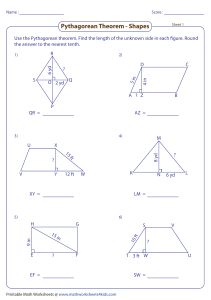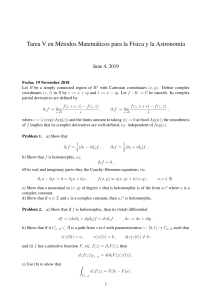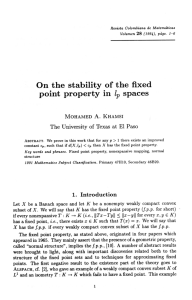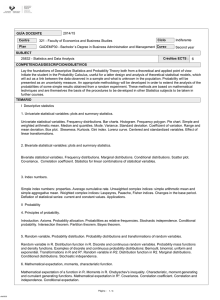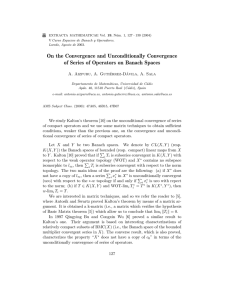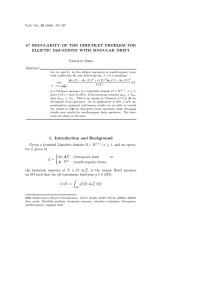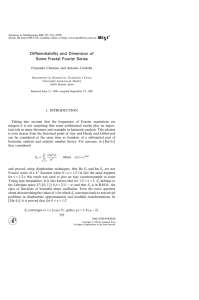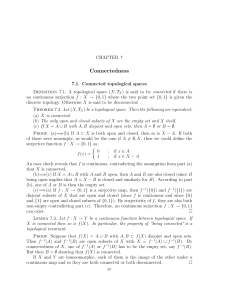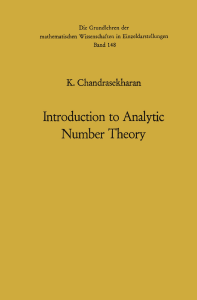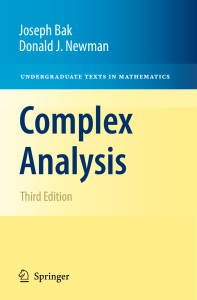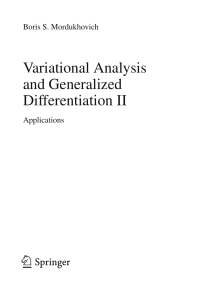A general approximation theorem of Whitney type
Anuncio
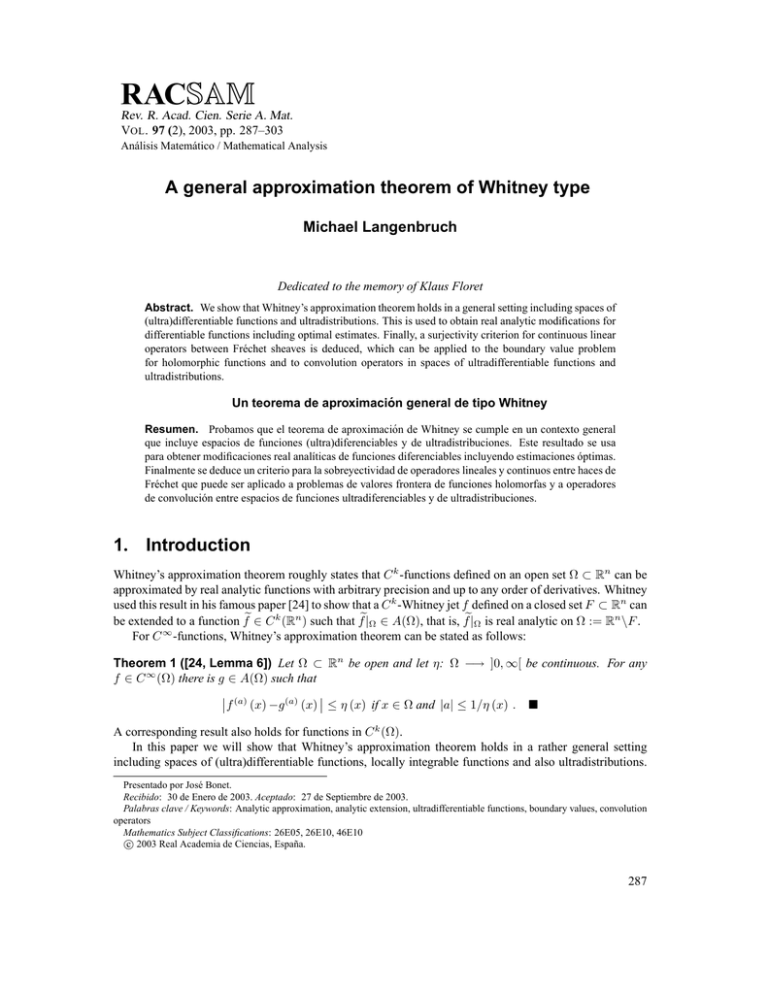
RACSAM
Rev. R. Acad. Cien. Serie A. Mat.
VOL . 97 (2), 2003, pp. 287–303
Análisis Matemático / Mathematical Analysis
A general approximation theorem of Whitney type
Michael Langenbruch
Dedicated to the memory of Klaus Floret
Abstract. We show that Whitney’s approximation theorem holds in a general setting including spaces of
(ultra)differentiable functions and ultradistributions. This is used to obtain real analytic modifications for
differentiable functions including optimal estimates. Finally, a surjectivity criterion for continuous linear
operators between Fréchet sheaves is deduced, which can be applied to the boundary value problem
for holomorphic functions and to convolution operators in spaces of ultradifferentiable functions and
ultradistributions.
Un teorema de aproximación general de tipo Whitney
Resumen. Probamos que el teorema de aproximación de Whitney se cumple en un contexto general
que incluye espacios de funciones (ultra)diferenciables y de ultradistribuciones. Este resultado se usa
para obtener modificaciones real analı́ticas de funciones diferenciables incluyendo estimaciones óptimas.
Finalmente se deduce un criterio para la sobreyectividad de operadores lineales y continuos entre haces de
Fréchet que puede ser aplicado a problemas de valores frontera de funciones holomorfas y a operadores
de convolución entre espacios de funciones ultradiferenciables y de ultradistribuciones.
1.
Introduction
Whitney’s approximation theorem roughly states that C k -functions defined on an open set Ω ⊂ Rn can be
approximated by real analytic functions with arbitrary precision and up to any order of derivatives. Whitney
used this result in his famous paper [24] to show that a C k -Whitney jet f defined on a closed set F ⊂ Rn can
be extended to a function fe ∈ C k (Rn ) such that fe|Ω ∈ A(Ω), that is, fe|Ω is real analytic on Ω := Rn \F .
For C ∞ -functions, Whitney’s approximation theorem can be stated as follows:
Theorem 1 ([24, Lemma 6]) Let Ω ⊂ Rn be open and let η: Ω −→ ]0, ∞[ be continuous. For any
f ∈ C ∞ (Ω) there is g ∈ A(Ω) such that
(a)
f (x) −g (a) (x) ≤ η (x) if x ∈ Ω and |a| ≤ 1/η (x) . A corresponding result also holds for functions in C k (Ω).
In this paper we will show that Whitney’s approximation theorem holds in a rather general setting
including spaces of (ultra)differentiable functions, locally integrable functions and also ultradistributions.
Presentado por José Bonet.
Recibido: 30 de Enero de 2003. Aceptado: 27 de Septiembre de 2003.
Palabras clave / Keywords: Analytic approximation, analytic extension, ultradifferentiable functions, boundary values, convolution
operators
Mathematics Subject Classifications: 26E05, 26E10, 46E10
c 2003 Real Academia de Ciencias, España.
287
M. Langenbruch
In fact, the key result can be stated as a decomposition lemma (see section 2) having a surprisingly short
functional analytic proof based on a surjectivity criterion for continuous linear mappings between Fréchet
spaces (see Meise, Vogt [14, 26.1]).
We then deduce Whitney’s approximation theorem for several concrete spaces from analysis. This
is applied to Whitney’s extension problem mentioned above using Ω-modification operators as they were
studied in Langenbruch [12].
In section 5 we finally prove a surjectivity criterion related to Whitney’s approximation theorem (see
Theorem 6), which roughly states that a continuous linear operator between Fréchet sheaves is surjective if
its range contains the sections with compact support and the real analytic functions. This is then applied to
the representation of ultradistributions as boundary values of holomorphic functions and to the surjectivity
of convolution operators in spaces of ultradifferentiable functions and ultradistributions, respectively.
The author wants to thank L. Frerick (Wuppertal) for several interesting discussions concerning the
subject of this paper.
2.
A decomposition lemma
In this section we will prove a basic decomposition lemma, which can be considered as a general version
of Whitney’s approximation theorem (see the discussion in section 3).
We use ultradifferentiable functions of Beurling type as a general frame for our considerations. The
reader is referred to Komatsu [9] for further information. In this paper, (Mp )p∈N0 always is a sequence of
positive numbers satisfying the following two standard assumptions
mp := Mp+1 /Mp is increasing
(M1)
P
(M30 )
and
1/mp < ∞ .
p
For Ω ⊂ Rn open let
n
E(Mp ) (Ω) := f ∈ C ∞ (Ω) ∀ K ⊂⊂ Ω ∀ C > 0 :
o
kf kK,C := sup f (a) (x) M|α| C |a| x ∈ K, α ∈ Nn0 < ∞
and
D(Mp ) (Ω) := f ∈ E(Mp ) (Ω) supp f ⊂⊂ Ω
be endowed with their natural topologies. E(Mp ) (Ω) is the space of ultradifferentiable functions of Beurling
type.
The assumptions needed for decomposition are summarized in the following definition:
Definition 1 Let Ω ⊂ Rn be open. Two Fréchet spaces F (Ω), E(Ω) are called a decomposition pair if
there is a sequence (Mp )p as above such that
i) E(Mp ) (Ω) ⊂ E(Ω) is dense and
id : E(Mp ) (Ω) −→ E(Ω) is continuous .
ii) D(Mp ) (Ω) ⊂ F (Ω) ⊂ E(Ω) and
id : F (Ω) −→ E(Ω) is continuous .
288
A general approximation theorem of Whitney type
iii) Let τE and τF be the topologies of E(Ω) and F (Ω), respectively. Then the mapping
Mϕ : D(Mp ) (Ω), τE −→ D(Mp ) (Ω), τF , f −→ ϕf ,
is continuous for ϕ ∈ D(Mp ) (Ω).
By Definition 1 i),
D(Mp ) (Ω) is dense in E(Ω) .
(1)
The mapping Mϕ from Definition 1 iii) thus can uniquely be extended to a continuous linear mapping
Mϕ : E(Ω) −→ F (Ω) .
(2)
For Ω ⊂ Rn open and ε > 0 let
Ω∗ := z ∈ Cn Re z ∈ Ω, | Im z| < dist(Re z, ∂Ω) and
Kε := x ∈ Ω dist(x, ∂Ω) ≥ ε and |x| ≤ 1/ε ,
and let Kε∗ := (Kε )∗ be defined similarly. Let H(Ω∗ ) denote the holomorphic functions on Ω∗ endowed
with the seminorms
|f |Kε∗ := sup |f (z) | z ∈ Kε∗ .
Lemma 1 Let F (Ω), E(Ω) be a decomposition pair. Then the mapping
A : H(Ω∗ ) × F (Ω) −→ E(Ω), A(f, g) := f |Ω + g ,
is surjective.
P ROOF. A is defined and continuous by Definition 1 i) and ii). Since all spaces involved are Fréchet
spaces, we have to show by Meise, Vogt [14, 26.1] that B ⊂ E(Ω)0b is bounded if
B|H(Ω∗ ) ⊂ H(Ω∗ )0b is bounded and
B|F (Ω) ⊂
F (Ω)0b
(3)
is bounded .
(4)
By (3) there are ε > 0 and C ≥ 1 such that
T (g) ≤ C|g|K ∗ if T ∈ B and g ∈ H(Ω∗ ) .
2ε
Let fk (z) := (k/π)n/2 exp −k
Pn
2
j=1 zj
(5)
and ϕ ∈ D(Mp ) (Ω\K2ε ). It is easily seen that
ϕ ∗ fk −→ ϕ in E(Mp ) (Rn ) and ϕ ∗ fk K ∗ −→ 0 .
(6)
2ε
We thus get for T ∈ B and ϕ ∈ D(Mp ) Ω\K2ε by Definition 1 i), (5) and (6)
T (ϕ) = lim T (ϕ ∗ fk ) ≤ C lim ϕ ∗ fk k
k
∗
K2ε
= 0.
(7)
Choose ψ ∈ D(Mp ) (Kε ) such that ψ = 1 near K2ε . Then (1) implies that
T = T |F (Ω) ◦ Mψ if T ∈ B
since this holds on D(Mp ) (Ω) by (7). B is thus bounded in E(Ω)0b by (8), (2) and (4).
(8)
289
M. Langenbruch
Remark 1 Since the Gauss - Kernel is real on Rn , the Decomposition Lemma also holds for real decomposition pairs E(Ω), F (Ω) with H(Ω∗ ) substituted by
HR (Ω∗ ) := {f ∈ H(Ω∗ ) | f |Ω is real valued }. The Decomposition Lemma will be applied in the next sections in several situations.
The holomorphic part in the Decomposition Lemma is defined on Ω∗ since we used the Gauss-kernels
fk in (6). In the case of one variable, this can be improved considerably:
Theorem 2 Let Ω ⊂ R be open and let F (Ω), E(Ω) be a decomposition pair. Then the mapping
A : H C\∂Ω ×F (Ω) −→ E(Ω), A(f, g) := f |Ω + g .
is surjective.
P ROOF. The theorem holds for Ω = R by the Decomposition Lemma. So let Ω 6= R and thus ∂Ω 6= ∅.
Similarly as above we have to show that B ⊂ E(Ω)0b is bounded if
B|H(C\∂Ω) ⊂ H(C\∂Ω)0b is bounded and
(9)
B|F (Ω) ⊂ F (Ω)0b is bounded .
(10)
By (9) there are ε > 0 and C ≥ 1 such that
T (g) ≤ C|g| e if T ∈ B and g ∈ H C\∂Ω
K3ε
(11)
e 3ε := z ∈ C\∂Ω |z| ≤ 1/(3ε) and dist(z, ∂Ω) ≥ 3ε .
where K
1
Let ϕ ∈ D(Mp ) Ω\K2ε . We want to show that T (ϕ) = 0 if T ∈ B. The support of ϕ has finitely
many components and we may assume that supp ϕ is contained in a component I := ]a, b[ of Ω with
−∞ ≤ a < b < ∞ (or −∞ < a < b ≤ ∞). Let a = −∞ and b < ∞ (The cases −∞ < a < b ≤ ∞ are
treated similarly). We can then assume that supp ϕ ⊂ ]− ∞, 1/2ε[ or supp ϕ ⊂ ]b − 2ε, b[. The first case
is treated as in the proof of the Decomposition
Lemma. To consider the second, we use the shifted Cauchy
kernels hk (z):= 1/ 2πi(z − i/k) and set ϕk := (hk − h−k ) ∗ (ϕ ⊗ δ). Then ϕk is
holomorphic on
C\ [b − 2ε, b] ×{−1/k, 1/k}. By Runge’s theorem, there is a sequence fj ∈ H C\{b} such that fj −→
ϕk uniformly on compact subsets of C\Jk , where Jk := [b−2ε, b]×{−1/k, 1/k} ∪ {b}×[−1/k, 1/k] .
Hence, fj −→ ϕk also in E(Mp ) (Ω) and we get by Definition 1i) and (11)
T (ϕk ) = lim T (fj ) ≤ C lim |fj | e
j
j
K3ε
= C|ϕk |Ke 3ε if T ∈ B and k ≥ 1/ε .
e 3ε and ϕk −→ ϕ in E(M ) (R), since the sequence converges in C(R) by
ϕk −→ 0 uniformly on K
p
the theorem of dominated convergence and since ∂xa ϕk = hk − h−k ∗ ∂xa ϕ ⊗ δ . We conclude that
T (ϕ) = lim T (ϕk ) = 0, and the proof is completed as for the Decomposition Lemma. k
3. Approximation theorems of Whitney type
In this section we will apply the Decomposition Lemma to deduce
approximation results of Whitney type
0
in several function spaces including the space D{Mp } (Ω) b of ultradistributions of Roumieu type (see
Example 1e)). Here and in the following Eb0 denotes the strong dual of a locally convex space E.
Let (Mp )p always be a sequence of positive numbers satisfying (M1) and (M30 ) and let k kΩ denote
the sup-norm on Ω.
290
A general approximation theorem of Whitney type
Example 1 Let η : Ω −→ ]0, 1/2] be continuous. The following spaces F (Ω), E(Ω) are decomposition
pairs:
a) E(Ω) := E(Mp ) (Ω) and F (Ω) := E(Mp ) (Ω, η) :=
f ∈ C ∞ (Ω) pk (f ) := sup kf (a) /η k(1+|a|) kΩ M|a| < ∞ if k ∈ N
a
b) E(Ω) := C ∞ (Ω) and F (Ω) := C ∞ (Ω, η) :=
n
o
f ∈ C ∞ (Ω) pk (f ) := sup kf (a) /η k kΩ |a| ≤ k/η (x) < ∞ if k ∈ N
c) For k ∈ N0 let E(Ω) := C k (Ω) and F (Ω) := C k (Ω, η) :=
n
o
f ∈ C k (Ω) p1 (f ) := sup kf (a) /ηkΩ |a| ≤ k < ∞
d) For 1 ≤ p < ∞ let E(Ω) := Lloc
p (Ω) and
F (Ω) := Lp (Ω, η) := f ∈ Lp (Ω) p1 (f ) := kf /ηkLp (Ω) < ∞
0
0
e) E(Ω) := D{Mp } (Ω, η) b and F (Ω) := E{Mp } (Ω, η) b where
D{Mp } (Ω) := f ∈ C0∞ (Ω) ∃ k ≥ 1 : kf kRn ,k < ∞ and
n
E{M } (Ω, η) := f ∈ C ∞ (Ω) p
o
∃ k ∈ N : qk (f ) := sup f (a) (x) η (x) k(1+|a|) M|a| x ∈ Ω, a ∈ Nn0 < ∞ .
P ROOF. The conditions in Definition 1 are trivially satisfied in the cases a) - d) (in case a), Definition 1iii)
is contained in Komatsu [9, Theorem 2.8]). In case e), E(Ω) and F (Ω) are Fréchet spaces, since the spaces
D{Mp } (Ω) and E{Mp } (Ω, η) of test functions are compact injective limits of Banach spaces, hence (DFS)spaces. To check Definition 1 we notice that i) is well-known, ii) holds since D{Mp } (Ω) is continuously
embedded and dense in E{Mp } (Ω, η), and iii) holds since
Mϕ : E{Mp } (Ω, η) −→ D{Mp } (Ω) is continuous. 0
E{Mp } (Ω, η) b is a weighted space of ultradistributions of Roumieu type endowed with its canonical
dual norms
(12)
pk (f ) := qk∗ (f ) := sup hf, ψi ψ ∈ E{Mp } (Ω, η), qk (ψ) ≤ 1 .
b) and c) of the following approximation theorem are Whitney’s results mentioned in the introduction. The
proof of the theorem via the Decomposition Lemma 1 is almost trivial.
Theorem 3 Let η : Ω −→ ]0, ∞[ be continuous.
a) For any f ∈ E(Mp ) (Ω) there is g ∈ H(Ω∗ ) such that
(a)
f (x) −g (a) (x) ≤ η (x) 1+|a| M|a| if x ∈ Ω and a ∈ Nn0
b) For any f ∈ C ∞ (Ω) there is g ∈ H(Ω∗ ) such that
(a)
f (x) −g (a) (x) ≤ η (x) if x ∈ Ω and |a| ≤ 1/η (x) .
291
M. Langenbruch
c) Let k ∈ N0 . For any f ∈ C k (Ω) there is g ∈ H(Ω∗ ) such that
(a)
f (x) −g (a) (x) ≤ η (x) if x ∈ Ω and |a| ≤ k .
∗
d) For any f ∈ Lloc
p (Ω), 1 ≤ p < ∞, there is g ∈ H(Ω ) such that
(f − g)/η L
p (Ω)
≤1
0
e) For any f ∈ D{Mp } (Ω) b there is g ∈ H(Ω∗ ) such that for any ψ ∈ D{Mp } (Ω)
hf − g, ψi ≤ sup ψ (a) (x) η (x) 1+|a| M|a| x ∈ Ω, a ∈ Nn0 .
P ROOF. We may assume that η(Ω) ⊂ ]0, 1/2[ and apply the Decomposition Lemma 1 to the Examples 1
a) – e). The mapping A is open since it is surjective and the spaces involved are Fréchet spaces. Hence,
there are a continuous seminorm k k on E(Ω) and C ≥ 1 such that for any f ∈ E(Ω) there is g ∈ H(Ω∗ )
such that
p1 (f − g) ≤ Ckf k .
(13)
Since H(Ω∗ ) is dense in E(Ω) (e.g. by Definition 1i) and (6)), there is g1 ∈ H(Ω∗ ) such that kf − g1 k ≤
1/C. With g2 ∈ H(Ω∗ ) chosen for (f − g1 ) by (13), we get for g := g1 − g2
p1 (f − g) ≤ Ckf − g1 k ≤ 1 .
This shows the claim in any of the five cases, where in case e) the definition (12) of the norm p1 in
E{Mp } (Ω, η)0b is used. The Approximation Theorem 3a), d) and e) provides a version of Whitney’s approximation theorem for
0
ultradifferentiable and Lloc
p -functions and for the space D{Mp } (Ω)b of ultradistributions of Roumieu type,
respectively.
Using Theorem 2 (and Runge’s theorem) instead of the Decomposition Lemma, we can substitute
H(Ω∗ ) by H(C\∂Ω) in the Approximation Theorem 3 if Ω ⊂ R.
4.
Whitney’s extension theorem
We already mentioned in the introduction that Whitney’s approximation theorem is connected to Whitney’s
extension theorem. In fact, Whitney’s approximation theorem is used to extend Whitney jets g defined on
F such that the extensions are analytic on Ω. Here and in the following
F ⊂ Rn is always closed and Ω := Rn \F .
This “analytic extension” may be obtained in two steps: first, g is extended to a function f ∈ C ∞ (Rn ) and
then an Ω-modification in C ∞ (Rn ) is chosen for f in the sense of the following
Definition 2 Let m ∈ N0 ∪ {∞} and f ∈ C m (Rn ). A function fe is called an Ω-modification in C m (Rn )
for f if fe ∈ C m (Rn ) and
fe is real analytic on Ω
(14)
∂ α fe = ∂ α f for any α ∈ Nn0 with |α| ≤ m.
(15)
F
292
F
A general approximation theorem of Whitney type
Ω-modifications and corresponding continuous linear Ω-modification operators have been studied by Valdivia [21, 22], Schmets and Valdivia ([17], [18], [19]) and Brück, Frerick [4] for differentiable and ultradifferentiable functions. Using boundary values of harmonic functions, we obtained in Langenbruch [12] a
unified short proof of these results and an explicit formula for a continuous linear Ω-modification operator
on
BC ∞ (Rn ) := f ∈ C ∞ (Rn ) f (a) is bounded for a ∈ Nn0 ,
whose restriction to classes of ultradifferentiable functions is also a continuous modification operator within
these classes.
To be precise, the following basic result was shown in Langenbruch [12, Theorem 1.2]: Assume that
there is h ∈ BC ∞ (Rn ) such that
h |Ω is real analytic, 0 < h |Ω ≤ 1 and ∂ α h = 0 for any α ∈ Nn0 .
F
For f ∈ BC ∞ (Rn ) let Th (f ) be defined by
Z
−(n+1)/2
2
f x − ξh (x) 1 + |ξ| 2
dξ for x ∈ Rn
Th (f ) (x) :=
cn+1
(16)
(17)
where cn+1 is the area of the unit sphere in Rn+1 . Then
Th : BC ∞ (Rn ) −→ BC ∞ (Rn ) is linear and continuous
(18)
Th (f ) is an Ω − modification in BC ∞ (Rn ) for any f ∈ BC ∞ (Rn ) .
(19)
and
Th is called an Ω - modification operator in BC ∞ (Rn ). The modification problem was thus reduced to the
existence of a function h satisfying (16). To estimate the derivatives ∂ a Th (f ) for |a| ≤ m in Langenbruch [12], we needed the derivatives ∂ β f
for |β| ≤ m + 1 if m is odd. So there was a loss of one derivative in these estimates (as in Schmets/Valdivia
[17]). This caused a (weak) additional assumption (compared with the papers of Schmets and Valdivia) in
[12], when ultradifferentiable functions were considered.
In his Habilitationsschrift [7, chapter 4] Frerick proved that there are extension operators without loss
of derivatives. We will show now that a slight variant of the operator Th from above will give an Ωmodification operator without loss of derivatives (and hence corresponding extension operators with optimal
continuity estimates).
More precisely, we will provide an operator T defined and continuous on BC 0 (Rn ) whose restrictions
to BC m (Rn ) are Ω - modification operators in BC m (Rn ) for any m ∈ N0 ∪ {∞}, that is, they are
continuous linear operators within these spaces and f˜ := T (f ) is an Ω - modification in BC m (Rn ) for any
f ∈ BC m (Rn ).
For this we need the following interpolation result: For I :=] − ∞, y] and g ∈ BC ∞ (I) let
|g|I := sup |g(x)| and kgkk := sup |g (a) |I .
x≤y
a≤k
Lemma 2 If 0 ≤ g ∈ BC ∞ (I) is strictly increasing on [0, y] and g(y) ≤ 1, then
lim |g (a) (y)| ln(1/g(y)) = 0 and
y&0
−a
|g (a) (y)| ln(1/g(y)) ≤ 2a+3 kgk1−2
a+1
for any a ∈ N.
293
M. Langenbruch
P ROOF.
By a standard interpolation inequality (see Beckenbach, Bellmann [1], p. 171) we have
1/2
1/2
|h0 |I ≤ 4|h|I |h00 |I
if h ∈ BC ∞ (I).
This is applied a times to obtain
1/2
1/2
|g (a) (y)| ≤ 4|g (a−1) |I |g (a+1) |I
Pa−1
≤4
j=0
2−j
|g|I2
−a
Pa
1/4
1/4
1/2
≤ 4 41/2 |g (a−2) |I |g (a) |I kgka+1
j=1
kgka+1
2−j
≤ 16 g(y)2
−a
−a
kgk1−2
a+1
since 0 ≤ g is increasing. The claim now follows directly since 1 ≥ g(y) > 0 and
sup xτ ln(1/x) =
x∈]0,1]
1
and lim xτ ln(1/x) = 0 if τ ∈]0, 1[. x&0
eτ
A modification operator without loss of derivatives is now obtained by means of one extra composition
with a function g ∈ BC ∞ (] − ∞, 2[) satisfying the following conditions similar to (16)
g |]0,2[ is real analytic and strictly increasing, g |[0,1] ≤ 1 and g |]−∞,0] = 0 .
(20)
We finally recall the formula of Fa di Bruno for the derivatives of the composition of two C ∞ - functions v
and g of one variable (see e.g. Krantz and Parks [11], Lemma 1.3.1):
g (1) (t) k1
g (b) (t) kb
b!
v (k) (g(t))
...
k1 ! . . . kb !
1!
b!
Pb
Pb
where k := j=1 kj . The sum is taken over all k1 , . . . kb for which j=1 jkj = b.
(v ◦ g)(b) (t) =
X
(21)
Theorem 4 Let h ∈ BC ∞ (Rn ) and g ∈ BC ∞ (]−∞, 2[) satisfy (16) and (20), respectively. Let T (f ) :=
Tg◦h (f ) be defined for f ∈ BC 0 (Rn ) by (17). Then T is an Ω-modification operator in BC m (Rn ) for any
m ∈ N0 ∪ {∞}.
P ROOF. a) T is an Ω - modification operator in BC 0 (Rn ).
Indeed, let
Z
f x − ξy
2
n
vf (x, y) :=
(n+1)/2 dξ for (x, y) ∈ R × [0, 1]
cn+1
1 + |ξ| 2
and wf (x, y) := vf (x, g(y)). Thus,
T (f ) (x) = wf x, h (x) .
(22)
Since (1 + | · |2 )−(n+1)/2 ∈ L1 (Rn ), T (f )(x) is defined for any x ∈ Rn and any f ∈ BC 0 (Rn ), and
kT (f )kRn ≤
sup
(x,y)∈Rn ×[0,1]
|vf (x, y)| ≤ C1 kf kRn if f ∈ BC 0 (Rn ).
(23)
Moreover,
wf ∈ BC 0 (Rn × [0, 1]) and wf ( · , 0) = f if f ∈ BC 0 (Rn )
(24)
by (23) and the theorem of dominated convergence. Hence T (f ) ∈ BC 0 (Rn ) by (22). T (f ) is real analytic
on Ω since g ◦ h is strictly positive and real analytic on Ω and since vf (x, y) is harmonic, hence real analytic
for y > 0. Thus, T (f ) is an Ω - modification in BC 0 (Rn ) for any f ∈ BC 0 (Rn ) by (24) and (22).
294
A general approximation theorem of Whitney type
b) To study T (f ) for f ∈ BC m (Rn ), we now estimate ∂y vf for f ∈ BC 1 (Rn ) :
|∂y vf (x, y)| ≤ (C + ln(1/y)) max{kf kRn , k grad(f )kRn } if (x, y) ∈ Rn × ]0, 1].
In order to do it, fix ϕ ∈ C0∞ (Rn ) such that ϕ(x) = 1 if kxk ≤ 1/2 and ϕ(x) = 0 if kxk ≥ 1. Then
Z
Z
f (x − ξ)(1 − ϕ(ξ))y
f (x − ξy)ϕ(ξy)
cn+1
dξ +
dξ,
vf (x, y) =
2
(1 + |ξ|2 )(n+1)/2
(y 2 + |ξ|2 )(n+1)/2
hence
Z
cn+1
−hgrad f (x − ξy), ξiϕ(ξy) + f (x − ξy)hgrad ϕ(ξy), ξi
dξ
∂y vf (x, y) =
2
(1 + |ξ|2 )(n+1)/2
Z
1
(n + 1)y 2
+ f (x − ξ)(1 − ϕ(ξ)) 2
−
)dξ.
(y + |ξ|2 )(n+1)/2
(y 2 + |ξ|2 )1+(n+1)/2
Since ϕ(yξ) = 0 if kξk ≥ 1/y, the first integral can be estimated by
Z 1/y
rn−1
dr
C1 max{kf kRn , k grad(f )kRn }
(1 + r2 )n/2
0
≤ C2 max{kf kRn , k grad(f )kRn } ln(1 + 1/y).
Similarly, the second integral is estimated by
Z
C3 kf kRn
(y 2 + |ξ|2 )−(n+1)/2 dξ ≤ C4 kf kRn .
kξk≥1/2
c) Let f ∈ BC m (Rn ) and m ∈ N. For j = (a, 2b + l) ∈ Nn+1
, l = 0, 1 and |j| ≤ m we have
0
∂ j vf (x, y) = (−1)b ∂yl v∂ a ∆b f (x, y) and ∂ j wf (x, y) = ∂y2b+l w∂ a f (x, y) for y > 0
since vf (x, y) is harmonic for y > 0. By b) we thus get for odd k ≤ m
k
∂y vf (x, y) ≤ (C5 + ln(1/y))C6k sup ∂ α f n if (x, y) ∈ Rn × ]0, 1] .
R
(25)
(26)
|α|≤k
For even k ≤ m, (26) (without the logarithmic term) directly follows from (25) and (23). So (26) holds for
any k 6= 0. By the formula of Fa di Bruno (21), Lemma 2, (25), (23) and (26) we thus get for j ∈ Nn+1
0
and 0 ≤ |j| ≤ m
j
∂ (wf (x, y)) ≤ C7 C |j| sup ∂ α f n if (x, y) ∈ Rn × ]0, δ] ,
(27)
8
R
|α|≤|j|
m
n
that is, wf ∈ BC (R ×]0, 1]). Moreover, by the same arguments and (24),
∂ a wf ∈ BC m (Rn × [0, 1]), lim ∂xa wf (x, y) = ∂ a f (x) if |a| ≤ m, and
y&0
lim ∂xa ∂yk wf (x, y) = 0 if k 6= 0 and |a| + k ≤ m.
y&0
(28)
that is, wf ∈ BC m (Rn × [0, 1]), T (f ) ∈ BC m (Rn ) and T is a continuous operator in BC m (Rn ).
To prove (15) we notice that ∂xa (T (f )(x)) = ∂xa (wf (x, h(x))) consists of the sum of (∂xa wf )(x, h(x)) and
certain products each containing (∂xα ∂yk wf )(x, h(x)) for some k 6= 0 and |α| + k ≤ m. We therefore get
by (28)
∂xa (T (f )(x)) = (∂xa wf )(x, 0) = ∂ a f (x) if |a| ≤ m and x ∈ F
since h(x) = 0. The theorem is thus proved.
The existence of Ω-modifications in C m (Rn ) for (unbounded) C m -functions now easily follows from
Theorem 4 and the Approximation Theorem:
295
M. Langenbruch
Corollary 1 Let m ∈ N0 ∪ {∞}. Any f ∈ C m (Rn ) has an Ω-modification fe in C m (Rn ).
P ROOF. By the Approximation Theorem 3b) and c) (for Ω = Rn ) there are f1 ∈ H(Cn ) and f2 ∈
BC m (Rn ) such that f = f1 + f2 . With the Ω-modification operator T from Theorem 4, we then set
fe := f1 + T (f2 ). To consider Ω-modification operators in classes of (Mp )-ultradifferentiable functions, we must choose
the function h in (16) such that
n
h ∈ BE(Lp ) (Rn ) := f ∈ C ∞ (Rn ) ∀ C > 0 :
o
kf kRn ,C := sup f (α) (x) L|α| C |a| α ∈ N0n , x ∈ Rn < ∞
where (Lp )p satisfies (M30 ),
1∗p := Lp /(pLp−1 ) is increasing
(M1∗ )
Lp ≤ Cε εp Mp for any ε > 0 .
(29)
and
(see Langenbruch [12]). Such a function h was constructed in loc. cit. using infinite products and some
subtle arguments from the theory of ultradifferentiable functions. We will now show that the existence of h
is an easy consequence of the Approximation Theorem 3a):
Proposition 1 There is h ∈ BE(Lp ) (Rn ) satisfying (16) if (Lp )p satisfies (M1) and (M30 ).
P ROOF. W.l.o.g. let L0 = 1. It is clear that there is H ∈ BE(Lp ) (Rn ) satisfying (16) such that 1/4 ≥
H > 0 on Ω. Set η := H/2|Ω and choose g ∈ HR (Ω∗ ) by the Approximation Theorem 3a) (and Remark
1) for f := H|Ω (and Lp instead of Mp ). Then
g (x) ≤ H (x) + g (x) −H (x) ≤ 1/2 and
g (x) ≥ H (x) − g (x) −H (x) ≥ H (x) /2 > 0 if x ∈ Ω .
Since H ∈ BE(Lp ) (Rn ) and H = 0 on F ⊃ ∂Ω, for any C > 0 there are C1 ≥ 1 and K ⊂⊂ Ω such that
we get from the Approximation Theorem 3a) for any a ∈ Nn0
(a)
g (x) ≤ g (a) (x) −H (a) (x) + H (a) (x) ≤ H (x) |a| L|a| + C1 C |a| L|a| ≤ 2C1 C |a| L|a| if x ∈ Ω\K .
Since g ∈ H(Ω∗ ) ⊂ E(Lp ) (Ω), this implies that
sup g (a) Ω C |a| L|a| < ∞ if C > 0 .
(30)
(31)
Set h (x) := g (x) if x ∈ Ω, and h (x) = 0 on F . Then h ∈ C ∞ (Rn ) and h is flat on F since by (30),
g (a) (x) −→ 0 if x −→ ∂Ω since H is flat on F ⊂ ∂Ω. (31) then shows that h ∈ BE(Lp ) (Ω). Since we have no loss of derivatives for the Ω-modification operator in Theorem 4, we get corresponding
operators in classes of ultradifferentiable functions without any extra assumption:
Theorem 5 There is an Ω-modification operator T in BE(Mp ) (Rn ) if (Mp ) satisfies (M1) and (M30 ).
P ROOF. By Langenbruch [12, Lemma 2.3] we can choose (Lp )p satisfying (M30 ), (M1∗ ) and (29). We
may assume that (Lp )p also satisfies
Lp+1 ≤ Ap+1 Lp for any p ∈ N0 .
296
(M20 )
A general approximation theorem of Whitney type
Choose h for (Lp )p by Proposition 1. RThen choose g1 for (Lp )p by Proposition 1 (for n = 1, F :=] − ∞, 0]
y
and Ω :=]0, ∞[) and set g(y) := c −∞ g1 (t) dt. Then g satisfies (20) for suitable c, and the operator
T := Tg◦h from Theorem 4 is an Ω - modification operator in BC ∞ (Rn ). Using the notation from the
proof of Theorem 4, we also know that wf ∈ BC ∞ (Rn × [0, 1]). By Komatsu [10, Remark after Theorem
4.4], composition with h is continuous in E(Mp ) since by (M30 )
Mγ (α − γ)! ≤ C |α| M|α| if γ ≤ α
(Komatsu [9, Lemma 4.1]). We thus have to show that wf ∈ BE(Mp ) (Rn ×]0, 1]) if f ∈ BE(Mp ) (Rn ). To
see this we use the formula of Fa di Bruno (21): Fix C > 0. For b ∈ N and y > 0 we get
|∂xa ∂yb wf (x, y)| = |∂yb v∂ a f (x, g(y)) |
(b)
(1)
k
b!
∂y v∂ a f (x, g(y)) g (y) k1 . . . g (y) kb k1 ! . . . kb !
1!
b!
X
b!
Lb+1 kb
L2 k1
≤ C1 2b C |a|
(C2 C)k M|a|+k
...
k1 ! . . . kb !
1!
b!
X
k1
k
b!
(C4 C)k M|a|+k L∗1 /(L∗0 l1∗ ) . . . L∗b /(L∗0 l1∗ ) b
≤ C3 (2A)b C |a|
k1 ! . . . kb !
X
X
b!
k!
≤ C5 (2A)b C |a|
(C4 C)k M|a|+k L∗b−k ≤ C5 (4A)b C |a|
(C6 C)k M|a|+k Lb−k
k1 ! . . . kb !
k1 ! . . . kb !
X
k!
C k ≤ C8 (C9 C)|a|+b M|a|+b
≤ C7 (4A)b C |a|+b M|a|+b
k1 ! . . . kb ! 6
≤
X
where the constants Ck are independent of C, b and y, and where we have used (25), (21), (26), Lemma 2,
(M20 ) and (M1∗ ) for (Lp )p , (29) and finally Lemma 1.3.2 from Krantz and Parks [11]. Qp+1
Notice that Lp := j=1 j (ln(1 + j))2 satisfies all assumptions needed in the proof of Theorem 5 and
that for any s > 1
Lp ≤ Cε εp (p!)s for any p ∈ N.
By Theorem 4 and 5, the operator T = Tg◦h constructed with h, g ∈ BE(Lp ) is an Ω - modification operator
in any of the standard classes of differentiable functions, namely in BCm (Rn ) for m ∈ N0 ∪ {∞} and in
the Gevrey classes γ s (Rn ) = BE(p!s ) (Rn ) and Γs (Rn ) = BE{p!s } (Rn ) for any s > 1 since Theorem 5
also holds for the classes BE{Mp } (Rn ) of ultradifferentiable functions of Roumieu type (by essentially the
same proof).
The existence of ultradifferentiable Ω-modifications for unbounded ultradifferentiable functions follows
from Theorem 5 as in Corollary 1.
5. A criterion for surjectivity
We will first prove a criterion for surjectivity of continuous linear operators between Fréchet spaces based
on the Decomposition Lemma 1. This will be applied to several linear problems of analysis including the
representation of ultradistributions as boundary values of holomorphic functions and solvability questions
for partial differential operators and convolution operators.
We begin with corresponding examples of decomposition pairs:
Remark 2 Let E(Ω) be a Fréchet space with the topology defined by an increasing sequence of seminorms
k kk . We assume that
a) E(Ω) is the space of sections on Ω of a sheaf E on Rn which has continuous restriction mappings
297
M. Langenbruch
b) there is (Mp )p such that
i) E(Mp ) (Ω) ⊂ E(Ω) is dense and
id : E(Mp ) (Ω) ⊂ E(Ω) is continuous
ii) For ϕ ∈ D(Mp ) (Ω) the mapping
Mϕ : D(Mp ) (Ω), τΩ −→ D(Mp ) (Ω), τΩ , f −→ ϕf ,
is continuous for the topology τΩ induced by E(Ω).
For a (fixed) locally finite resolution of the identity (ϕn )n∈N ⊂ D(Mp ) (Ω) on Ω and increasing sequences
(jn )n∈N ⊂ N and (Cn )n∈N ⊂ [1, ∞[ we define
o
X
n
nk
Mϕ (f ) C
2
<
∞
.
E (jn ), (Cn ); Ω := f ∈ E(Ω) ∀ k ∈ N : qk (f ) :=
n
n
jn +k
n∈N
Then E (jn ), (Cn ); Ω , E(Ω) is a decomposition pair.
P ROOF. I) F (Ω) := E (jn ), (Cn ); Ω is defined since Mϕn (f ) is defined for f ∈ E(Ω) by b)i), b)ii)
and continuous extension.
II) Definition 1 i)–iii) is satisfied.
Indeed i) holds by assumption. D(Mp ) (Ω) ⊂PF (Ω) by Remark 2b)i) and 2b)ii) since the sum defining
qk (f ) then is finite. For f ∈ F (Ω), the sum
Mϕn (f ) absolutely converges in E(Ω) with limit f (use
assumption a)). It is thusclear that F (Ω) is continuously embedded in E(Ω). iii) is also evident since the
sum defining qk Mϕ (f ) is finite for ϕ ∈ D(Mp ) (Ω).
III) F (Ω) is complete. Indeed, if (fj )j∈N is a Cauchy sequence in F (Ω), then by Definition 1ii), (fj )j∈N
converges in E(Ω) with limit f .
Cn 2n(k+1) ≤ ε + Mϕn fj − fm Cn 2n(k+1) ≤ 2ε
Mϕn fj − f jn +(k+1)
jn +(k+1)
if j ≥ j0 (ε) (and m ≥ m0 (ε, n)). Thus,
qk (fj − f ) ≤ ε if j ≥ j0 ,
f ∈ F (Ω) and lim fj = f in F (Ω).
For E(Ω) as in Remark 2 and a compact K ⊂ Ω we set
E0 (K) := f ∈ E(Ω) supp (f ) ⊂ K and E0 (Ω) :=
[
E0 (K) .
K ⊂⊂ Ω
We now prove that continuous linear mappings into E(Ω) are surjective if the range contains E0 (Ω) and
H(Ω∗ ). The latter condition is easily verified in many concrete situations.
Theorem 6 Let E be a Fréchet space and let E(Ω) satisfy the assumptions of Remark 2. Let G be a
locally convex space containing E(Ω) as a continuously embedded subspace and let
T : E −→ G be linear and continuous.
Then range (T ) ⊃ E(Ω) if range (T ) ⊃ E0 (Ω) ∪ H(Ω∗ ) .
298
A general approximation theorem of Whitney type
P ROOF.
E0 (K) is a Fréchet space for K ⊂⊂ Ω by Remark 2a). The mapping
T −1 : E0 (K) −→ E/ ker(T )
is defined and closed by assumption. Hence T −1 is continuous. Choose a compact exhaustion (Kn )n∈N
of Ω. Then for any n ∈ N there are increasing sequences j(n) ∈ N and C(n) ≥ 1 such that for any
g ∈ E0 (Kn ) there is h ∈ E with T (h) = g such that
khkE
n ≤ C (n) kgkj (n) if g ∈ E0 (Kn ) .
(32)
Fix a resolution of the identity (ϕn ) as in Remark 2 with supp ϕn ⊂ Kn and set
F (Ω) := E (j (n)), C (n) ; Ω .
By Remark 2 and the Decomposition Lemma, for f ∈ E(Ω) we can then choose fe ∈ H(Ω∗ ) such that
P
(f − fe) ∈ F (Ω). Choose hn ∈ E for gn := Mϕn (f − fe) ∈ E0 (Kn ) as in (32). Then h := n hn ∈ E
exists since
X E X Mϕn (f − fe)
hn ≤
C (n) 2n < ∞
j (n)
k
n
n≥k
by (32) and the choice of F (Ω). Also,
T (h) =
P
T (hn ) =
P
Mϕn (f − fe) = f − fe
n
n
since T is continuous and linear. This proves the theorem since fe ∈ H(Ω∗ ) and thus there is Fe ∈ E with
T (Fe) = fe by assumption. Theorem 6 can often be used as a substitute for the Mittag-Leffler procedure. Roughly, the approximation procedure is realized in Theorem 6 in the range space of T . No density condition for the kernel
spectrum of T is needed.
loc
We now give some standard examples for Remark 2, including Hörmander’s spaces Bp,k
(Ω), the space
m
0
D (Ω)b of distributions of order m and the spaces of ω-ultradifferentiable functions and ω-ultradistributions
(see Björck [3] and Braun, Meise and Taylor [5], which will be used as standard reference).
Here ω : [0, ∞[ −→ [0, ∞[ is an increasing continuous function such that
ω(2t) ≤ A ω(t) + 1 for any t ≥ 0
(33)
Z ∞
ω(t)/(1 + t2 ) dt < ∞
(34)
0
ϕ := ω ◦ exp is convex on R and lim ϕ (x) /x = ∞ .
x−→∞
(35)
(33) - (35) are the conditions (α) − (γ) of Braun, Meise and Taylor [5]. By (35) the Young conjugate ϕ∗ of
ϕ is defined. Let
n
E(ω) (Ω) := f ∈ C ∞ (Ω) ∀ K ⊂⊂ Ω, ∀ C > 0 :
o
|f | K,C := sup f (a) (x) exp −ϕ∗ (|a| C)/C x ∈ K, a ∈ Nn0 < ∞
D{ω} (Ω) := f ∈ C0∞ (Ω) ∃ C > 0 : |f |Rn ,C < ∞
be endowed with their natural Fréchet topology (and (DFS)-topology, respectively).
Example 2 The following spaces satisfy the assumptions of Remark 2:
299
M. Langenbruch
a) i) E(Mp ) (Ω)
ii) E(ω) (Ω)
b) C k (Ω) for k ∈ N0 ∪ {∞}.
c) Lloc
p (Ω), 1 ≤ p < ∞.
loc
d) Bp,k
(Ω), 1 ≤ p < ∞, for weights k ∈ K (see Hörmander [8, section 10.1]).
0
e) Dm (Ω)0b := f ∈ C m (Ω) supp f ⊂⊂ Ω b for m ∈ N0 .
f) i) D{Mp } (Ω)0b
ii) D{ω} (Ω)0b .
P ROOF. The cases a)i), b), c) and f)i) were already treated in Example 1. For d) we refer to Hörmander [8,
Theorems 10.1.7 and 10.1.15]. e) is easy. To prove a)ii) and f)ii), an easy construction provides a sequence
(Mp ) with (M1) and (M30 ) such that E(Mp ) (Ω) ⊂ E(ω) (Ω). Anyway, the spaces E(ω) (Ω) could also take
the role of E(Mp ) (Ω) as general frame in this paper. As a first application of Theorem 6 we consider ultradistributional boundary values of holomorphic
functions. The situation is the following:
For f ∈ H (C\R)n the boundary value R (f ) in the sense of D{Mp } (Rn )0b is defined if the limit
hR (f ), ϕi :=
X
ε∈σ
lim
y−→0
n
Y
Z
εj
f (x + iεy)ϕ (x) dx
j=1
exists for any ϕ ∈ D{Mp } (Rn ) (here σ := {1, −1}n ). The boundary value problem can now be divided
into two parts:
i) Find a weighted space HW of holomorphic functions defined on (C\R)n such that the ultradistributional boundary value R (f ) exists for any f ∈ HW .
ii) Show that any ultradistribution is the boundary value of some f ∈ HW , i.e. that the boundary value
mapping
R : HW −→ D{Mp } (Rn )0 is surjective .
The second problem is usually solved by means of topological tensorproducts (see Petzsche [15]) while the
use of Theorem 6 provides an elementary proof. We need the following assumption: there is A ∈ N such
that for any p ∈ N
m∗p + 2 ≤ m∗Ap
where m∗p := Mp
(M40 )
Mp−1 p . Let
M ∗ (t) := sup tp p!M0 /Mp p ∈ N for t ≥ 0
and let H {Mp } denote the set of functions f ∈ H (C\R)n such that for any closed cone Γ ⊂ {y ∈
Rn | yj 6= 0 for any j} and any L > 0
|f (z) | ≤ CL exp M ∗ (L/| Im z|) if Im (z) ∈ Γ .
Theorem 7 Let (Mp ) satisfy (M1∗ ), (M20 ), (M30 ), and (M40 ). Then
R : H {Mp } −→ D{Mp } (Rn )0 is surjective .
300
A general approximation theorem of Whitney type
P ROOF. The boundary value R (f ) exists for f ∈ H {Mp } by Schroer [20, 5.1] (see also Komatsu [9]
and Petzsche/Vogt [16], where slightly stronger assumptions are used). Also by loc. cit., R H({Mp }) ⊃
E{Mp } (Rn )0b .
Clearly, R H({Mp }) ⊃ H(Cn ) since
R(fe) = f |Rn for f ∈ H(Cn ) ,
where fe(z) := f (z) if Im zj > 0 for any j and fe(z) := 0 otherwise. The claim now follows from
Theorem 6 and Example 2. The boundary value problem for distributions and ultradistributions of Beurling type is much more
involved (see Vogt [23] and Petzsche [15]).
As a second application of Theorem 6 we notice that in the situation of Example 2, sections on Ω may
be extended modulo H(Ω∗ ) to global sections:
Proposition 2 Let E(Ω) be one of the spaces from Example 2. Then for any f ∈ E(Ω) there are F ∈
E(Rn ) and g ∈ H(Ω∗ ) such that f = F |Ω + g.
P ROOF.
This follows from Theorem 6 applied to
T : E(Rn ) × H(Ω∗ ) −→ E(Ω), T (F, g) := F |Ω + g . We now consider convolution operators. Let µ ∈ E(Rn )0 where
0
E = C ∞ or E = E(ω) or E = D{ω} .
(36)
Let Ω1 , Ω2 ⊂ Rn be open and let supp(µ) + Ω1 ⊂ Ω2 . Then the convolution operator
µ∗ : E(Ω2 ) −→ E(Ω1 )
is defined, continuous and linear (see e.g. Hörmander [8, chapter 16] and Bonet, Galbis, Meise [2]). We
now get the following result:
Theorem 8 In the above situation the following statements are equivalent:
a) µ∗ : E(Ω2 ) −→ E(Ω1 ) is surjective.
b) i) µ ∗ E(Rn ) ⊃ E0 (Rn ) and
ii) µ ∗ E(Ω2 ) ⊃ H(Ω∗1 ).
P ROOF.
“ b) =⇒ a)”
It is well known that
κ ∗ : H(Cn ) −→ H(Cn ) is surjective
for any κ ∈ H(Cn )0 (see Ehrenpreis [6] and Malgrange [13]). Hence
µ ∗ E(Rn ) = E(Rn )
(37)
(38)
by Theorem 6 and b)i). Using (38) and b)ii) Proposition 2 implies that µ ∗ E(Ω2 ) = E(Ω1 ).
“a) =⇒ b)” ii) clearly holds. i) follows from Hörmander [8, Theorem 16.5.7] and Bonet, Galbis and Meise
[2, Proposition 2.6, Corollary 2.9, and Theorem 3.5], respectively. Condition 8 b)i) is equivalent to (38) and to the existence of an elementary solution in D(Rn )0 (and in
D(ω) (Rn )0 , and in D{ω} (Rn )0 , respectively). Further equivalent conditions for surjectivity of convolution
operators are given in the detailed paper of Bonet, Galbis and Meise [2].
Since any partial differential operator P (D) with constant coefficients has a distributional elementary
solution, Theorem 8 implies the following result which was first proved by Zampieri [25]:
301
M. Langenbruch
Corollary 2 Let Ω ⊂ Rn be open. If P (D)A(Ω) = A(Ω), then P (D)C ∞ (Ω) = C ∞ (Ω), i.e. Ω is
P -convex for supports. Acknowledgement. The author wants to thank L. Frerick (Wuppertal) for several interesting discussions concerning the subject of this paper.
References
[1] Beckenbach, E.F. and Bellmann, R. (1983). Inequalities. Springer, Berlin.
[2] Bonet, J., Galbis, A. and Meise, R. (1997). On the range of convolution operators on non-quasianalytic ultradifferentiable functions. Stud. Math., 126, 2, 171–198.
[3] Björck, G. (1965). Linear partial differential operators and generalized distributions. Ark. Mat., 6, 351–407.
[4] Brück, R. and Frerick, L., Holomorphic extension of Whitney jets, preprint.
[5] Braun, R.W., Meise, R. and Taylor, B.A. (1990). Ultradifferentiable functions and Fourier analysis. Result.
Math.,17, 207–237.
[6] Ehrenpreis, L. (1955). Mean periodic functions I, Am. J. Math., 77, 293–328.
[7] Frerick, L. (2001). Extension operators for spaces of infinitely differentiable Whitney functions, Habilitationsschrift, Wuppertal.
[8] Hörmander, L. (1983). The Analysis of Linear Partial Differential Operators I+II, Grundlehren Math. Wiss. Bde.
256+257. Springer, Berlin/Heidelberg/New York.
[9] Komatsu, H. (1973). Ultradistributions I. Structure theorems and a characterization. J. Fac. Sci. Tokyo Sec. IA,
20, 25–105.
[10] Komatsu, H. (1977). Ultradistributions II, The kernel theorem and ultradistributions with support in a submanifold. J. Fac. Sci. Univ. Tokyo, Sect. IA, 24, 607–628.
[11] Krantz, S. and Parks, H. (1992). A primer on real analytic functions. Birkhäuser, Basel.
[12] Langenbruch, M. (1999). Analytic extension of smooth functions. Result. Math. 36, 281–296.
[13] Malgrange, B. (1955/56). Existence et approximation des solutions des equations aux dérivées partielles et des
equations de convolution. Ann. Inst. Fourier (Grenoble), 6, 271–355.
[14] Meise, R. and Vogt, D. (1992). Einführung in die Funktionalanalysis. Vieweg, Braunschweig/Wiesbaden.
[15] Petzsche, H.J. (1984). Generalized functions and boundary values of holomorphic functions. J. Fac. Sci. Univ.
Tokyo, Sect. IA, 31, 391–431.
[16] Petzsche, H.J. and Vogt, D. (1984). Almost analytic extension of ultradifferentiable functions and boundary values
of holomorphic functions. Math. Ann., 267, 17–35.
[17] Schmets, J. and Valdivia, M. (1997). On the existence of continuous linear analytic extension maps for Whitney
jets. Bull. Polish Acad. Sc. Math., 45, 359–367.
[18] Schmets, J. and Valdivia, M. (1997). Analytic extension of non quasi-analytic Whitney jets of Roumieu type.
Result. Math., 31, 374–385.
[19] Schmets, J. and Valdivia, M. (1998). Analytic extension of non quasi-analytic Whitney jets of Beurling type.
Math. Nachr., 195, 187–197.
[20] Schroer, G. (1989). Ultradistributionen und ultradistributionelle Randwerte holomorpher Funktionen, Diplomarbeit, Münster.
302
A general approximation theorem of Whitney type
[21] Valdivia, M. (1996). On certain analytic function ranged linear operators in spaces of ultradifferentiable functions.
Mathematica Japonica, 44, 415–436.
[22] Valdivia, M. (1996). On certain linear operators in spaces of ultradifferentiable functions. Results in Math., 36,
321–345.
[23] Vogt, D. (1973). Distributionen auf dem RN als Randverteilungen holomorpher Funktionen. J. Reine Angew.
Math. 261, 134–145.
[24] Whitney, H. (1934). Analytic extension of differentiable functions defined on closed sets. Trans. Am. Math. Soc.,
36, 63–89.
[25] Zampieri, G. (1980). A link between C ∞ and analytic solvability for P.D.E. with constant coefficients, Rend.
Sem. Mat. Univ. Padova, 63, 145–150.
M. Langenbruch
Department of Mathematic
University of Oldenburg
D-26111 Oldenburg
Germany
[email protected]
303
